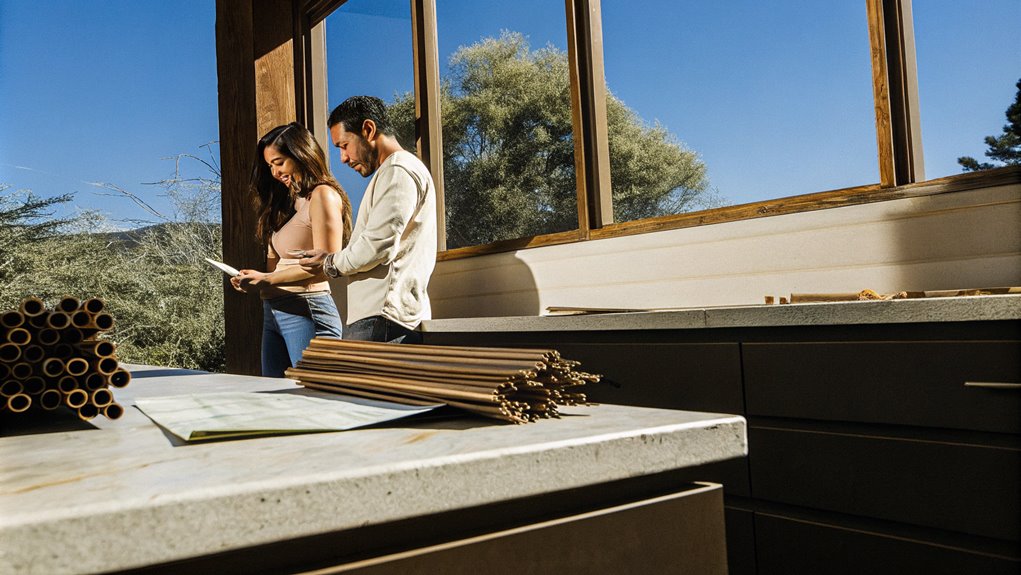Want to turn your kitchen project into a fun trip? You can! Pick new machines that use less power – they'll save you money each month. If you do some of the work yourself, like putting in cabinets, you keep more cash in your pocket. When you store food better, less goes to waste. Buy new things when they're on sale – cabinets cost less in December, and big machines cost less in October. A good kitchen layout helps you save too. Even selling old parts can give you extra money. Add it all up, and you'll have enough saved to pack your bags and go on that trip you've been dreaming about.
Energy-Efficient Appliance Cost Savings

Your kitchen can save you money when you pick appliances that use less power. Just like picking the right light bulbs, smart kitchen choices help your wallet and the Earth. Many families save $100 to $300 each year by getting these better machines.
New fridges are much better than old ones. A fridge you buy today uses less than half the power of one from 20 years ago. This means you keep about $80 in your pocket each year.
New dishwashers also help you save. They use less water and power, cutting $25 to $40 from your bills.
When you get new kitchen tools all at once, you can get money back. Many power companies give you $100 to $500 when you buy machines that save energy.
After a few years, the money you save could pay for a fun trip with your family.
Smart Storage Solutions
Your kitchen can work better for you with smart storage ideas. When things are easy to find, you waste less food and save money. Many families have found they throw away less food – about a third less! This means more cash stays in your wallet.
Think about adding pull-out shelves in your pantry. You'll find what you need in half the time. Put dividers in your drawers and add tall racks in your cabinets. This lets you store more stuff in the same space.
A lazy Susan is like a round tray that spins. It helps you reach things in corner cabinets better. They cost between $50 and $200.
You can also get drawers that go under your cabinets. These use space that would be empty and give you more room to store things. They cost $25 to $75.
These simple fixes help keep your kitchen neat and save you money. You can use that extra cash for fun things, like a trip!
DIY Versus Contractor Work

Thinking about fixing up your kitchen? You can do the work yourself or get someone else to help. If you do it yourself, you can save a lot of money – almost half of what you'd pay someone else.
Here's what you might save by doing it yourself:
| Task Type | DIY Savings | What a Pro Gives You |
|---|---|---|
| Painting | $800-1,200 | Better look |
| Putting in Cabinets | $2,000-3,500 | Promise to fix if broken |
| New Floors | $1,500-2,800 | Gets done faster |
Ask yourself: Are you good at fixing things? Do you have time? While you can save money doing it yourself, some jobs need an expert. Things like pipes and wires should be left to pros who know what they're doing.
You can save the most money by mixing both ways. Do the easy stuff yourself, like taking out old items, painting walls, and putting on new handles. Let the pros handle the hard stuff. Many people do this and it works well for them.
Seasonal Material Deals
Stores want to help you save money on your kitchen projects. They offer big sales at certain times of the year. You can save lots of money if you know when to shop.
Want new cabinets? Look for sales in December and January.
Need a new countertop? Shop in early spring.
Thinking about new kitchen tools like stoves or fridges? Wait for holiday weekends or shop in October and November.
If you need tiles, shop in July and August when stores clear out old items.
For new lights, try March or September. These are the best times to find low prices.
Join store reward programs to hear about sales first.
Ask stores if they'll match low prices you find at other places.
Buy many items at once – stores often give you extra money off when you do.
Kitchen Layout Money-Saving Tips

Your kitchen can look great and cost less when you plan it well. Smart layouts help you save money while making your kitchen work better for you.
You can save a lot by putting things in the right spots. Many people save up to 20% of their costs just by planning ahead.
How to save money with your kitchen layout:
- Put your sink and dishwasher close to each other. This means shorter pipes and saves you up to $2,000.
- Use normal-sized cabinets instead of special ones. This cuts your cabinet costs by almost one-third.
- Keep your sink, stove, and fridge close. Make sure you can walk less than 26 feet between them.
- Plan where to put power outlets early. This saves you from breaking walls later and saves up to $800.
When you plan your kitchen this way, you get two good things: you spend less money now, and your kitchen is worth more later.
Lighting Choices That Reduce Bills
Your kitchen lights can save you money when you pick the right ones.
LED lights are much better than old bulbs. They use less power and work for many more years.
Put in sensors that turn lights off when you leave the room. This way, you don't waste power.
These simple fixes can cut your light bill from $300 to $100 each year.
Think of all the money you could save to spend on other fun things in your kitchen!
LED Vs Traditional Bulbs
LED bulbs are much better than old light bulbs. They use way less power and last much longer too.
Want to save money in your kitchen? Switch to LED lights! Yes, LED bulbs cost more when you buy them. But they help you save money in four ways:
- They use less power, so you pay less on your power bill – about $100-300 less each year.
- They last longer – one LED light works for 25,000 hours while old bulbs only last 1,000 hours.
- They stay cool – this means your AC doesn't have to work as hard.
- They light up right away – no waiting for them to get bright.
Smart Motion Sensors Save
Light sensors help you save money on your power bills. They turn lights on when you walk in and off when you leave. This stops lights from staying on when no one is around.
These helpers work best in your pantry, under kitchen counters, and storage spots. People often forget to turn off lights in these places. The sensors pay for themselves in just half a year.
The new sensors are easy to use. You can change how they work to fit your needs. Each sensor costs about $15 to $30 and works well for many years. Some smart ones can even tell when there's enough daylight and won't turn on.
Many people use these sensors and save $50 to $100 each year on each light. They also make life easier since you don't have to look for light switches.
Resale Value Benefits

Your kitchen can be worth more money when you fix it up. Most people get back $50-80 for every $100 they spend on making their kitchen better. This makes it a smart way to spend money on your home.
Want to make your kitchen worth more? Try these fixes that buyers love:
- New, power-saving kitchen tools
- Pretty stone tops and new cabinets
- Adding a big counter in the middle
- Making the kitchen open to other rooms
You get to enjoy your nice kitchen now. Later, when you sell your home, the money you get back can pay for fun things like trips.
Homes with new kitchens sell much faster than homes with old kitchens. In fact, they sell about 25% faster.
Water Conservation Features
Saving water in your kitchen helps both your wallet and the Earth. Many of your friends have put in new faucets that use less water. These special faucets cut water flow by 20%. Wave your hand near a smart faucet, and water flows only when you need it. This can save 700 gallons of water each year.
A new dishwasher uses just 3 gallons to clean your dishes. If you wash by hand, you use 27 gallons. That's a big change!
You can also get a filter under your sink to make tap water taste better. This means no more buying water in bottles. You save money and make less trash.
A small device can tell your phone how much water you use. It helps you find leaks and bad habits. These new items cost money at first, but they save so much that they pay for themselves in less than two years.
Bulk Shopping Kitchen Design

Your kitchen needs lots of up and down space for big bulk items. Think tall shelves you can move around to fit your big boxes and jars.
Group similar items together – like baking stuff in one spot and snacks in another.
Set up your pantry so you use old food first. Shelves that pull out or spin make it easy to grab what you need. This helps stop food from going bad in the back of your pantry.
Get clear boxes that stack on top of each other and seal tight. When you can see what's inside, it's easier to find things.
These boxes help you fit more in your space and keep your food fresh longer.
Maximize Storage Space Efficiency
You can save lots of money when you buy food in big boxes. If you make room in your kitchen, you can buy more at once and pay less. When you store food the right way, it stays fresh longer too.
Make your kitchen work better with these smart ideas:
- Get shelves that pull out and move up and down. You can fit more boxes and bags this way.
- Use deep drawers with walls inside to keep rice, beans, and jars neat.
- Put flat things like cookie sheets in tall spaces under your cabinets.
- Add round shelves that spin in corner cabinets to reach everything easy.
These changes help you store more food in the same space. When you can store more, you can save more money on food.
Smart Pantry Layout Essentials
Your pantry can help you save money when you shop smart. Get shelves that are deep enough to hold lots of food. Use clear boxes so you can see what's inside. Make sure you can move the shelves up or down to fit tall and short items.
Keep your food in groups. Put breakfast foods where you can see them well. Baking items go below that. Big bags of rice and other bulk foods go at the bottom. Write down what you have and when it goes bad. This helps you buy things when they cost less.
Add lights that turn on when you walk in. They help you see in dark spots. Use the back of your door to hold small things like spices. When you save space, you save money too.
Bulk Container Organization Systems
Your kitchen storage can be so much better with the right containers. You can save money by buying food in bulk and keep your space neat. Good containers also help you cook with less mess and waste less food.
Look for these must-have things in your containers:
- Strong lids that lock tight to keep your food fresh longer and save your money
- Square boxes that stack well and let you store more food than round ones
- See-through plastic that has marks to help you know when to buy more
- Big openings on top so you can scoop food out without making a mess
Meal Planning Space Optimization
Your kitchen should have three main spaces to help you plan meals better: a place to get food ready, a place to cook, and a place to store things. When you set these spaces up well, you'll spend less money on food and waste less.
Keep your prep space close to where you cook. This means fewer steps back and forth. You'll save time – about half an hour each week!
Put up a board on the wall where you can write down what food you have and what meals you want to make.
Make sure your food storage is next to where you get food ready. Put food in clear boxes with labels that show when food goes bad. This helps you use food before it spoils.
You can also get special shelves that pull out – they save space and let you see all your food at once.
Recycling and Waste Management

Your kitchen can work better with spaces for recycling. When you make smart choices about trash, you help the Earth and save money too. You can save $300 each year!
Try these simple steps:
- Get bins that pull out from under your sink. Put paper in one, plastic in another, and food scraps in the last one. Cost: $50-$150
- Keep a small bin on your counter for food scraps. It helps make good dirt for your garden. Cost: $20-$40
- Get a tool that makes cans flat. You won't need to go to the recycling place as much. Cost: $30
- Put a holder on your door to keep shopping bags neat. Cost: $15
These easy changes help you save for fun things like trips. Your clean kitchen will make you feel good, and others will notice too!
Multi-Purpose Kitchen Elements
Your kitchen can do more when you add smart storage spots. Think drawers that hide in the bottom of cabinets and pull-out shelves. These neat tricks save lots of space.
You can also add tables that fold into the wall when you don't need them. This gives you more room to work.
And when friends come over, your kitchen can change! The island can grow bigger, and seats can nest together. This means you can fit two people or eight people at your table.
When everyone leaves, just fold things away and get your space back.
Hidden Storage Solutions
Want more kitchen storage without spending too much? You can get 40% more space with some smart tricks. Many people miss these simple ways to add storage.
Let's look at ways to hide more stuff in your kitchen:
- Put drawers under your bottom cabinets. These drawers fit in the space where your toes go. You can store things you don't use much here. It costs about $200.
- Make your corner cabinets work better. Special pull-out shelves help you reach way back into the corners. These cost $150 to $300.
- Put dividers in your cabinets. This helps you store flat things like cookie sheets and cutting boards. You can fit twice as many items this way. Dividers cost $25 to $75.
- Hide storage behind nice wall panels. This gives you 25% more space and looks clean. It costs $300 to $500.
Fold-Away Work Surfaces
Fold-away surfaces help make your kitchen bigger without taking up more room. A simple table that hangs on your wall can give you lots of space to work. When you need it, pull it down. When you don't, fold it up. It's like magic!
You can also get cutting boards that slide out from under your counter. These cost less than building new counters.
Some people add a small table that folds up like a bed on the wall. This is great for eating breakfast or doing homework.
Many people love these fold-away surfaces. They make their kitchens work better and save money too.
With the money you save, you could even take a nice trip! Your kitchen will work better, and you'll have more room to cook and move around.
Convertible Dining Spaces
Dining spaces that change with your needs help you make the most of your home.
When your kitchen table can turn into other things, you save space – about the size of a small bedroom! This means you spend less money on heating and cooling. Your bills can drop by 15-20% each month.
Want to save money? Try these smart ideas:
- Get a table that folds into the wall – it costs $200
- Buy benches with space inside to store stuff – they cost $350-500
- Use a rolling kitchen cart that works as a table too – it costs $600
- Pick chairs you can stack and put in a closet – they cost $75 each
When you use these ideas instead of building a new dining room, you can save $3,000-5,000.
Your home will work better for you, and you'll have more money in your pocket.








